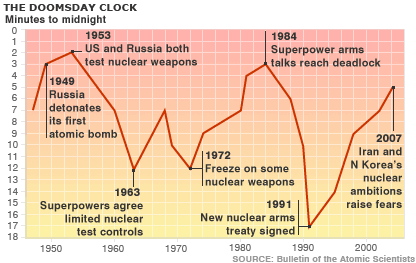This graphic shows how close to the midnight of humanity's annihilation that the minute hand approached in the 60 years since the "Doomsday Clock" has been kept. Individual minutes until midnight are depicted as squares on the y-axis, while each year is on the x-axis. The closest the minute hand ever approached midnight was 1953, when it was 2 minutes until midnight, and 1984, when it was three minutes to midnight. The BAS began keeping this clock in 1947.
Image source: Bulletin of the Atomic Scientists.
Experts who assess the dangers posed to civilization added climate change to the prospect of nuclear annihilation as posing the greatest threats to the continued existence of humankind. As a result, they moved the minute hand on their famous "Doomsday Clock" two minutes closer to midnight, which symbolizes total annihilation of human civilization.
"When we think about what technologies besides nuclear weapons could produce such devastation to the planet, we quickly came to carbon-emitting technologies," said Kennette Benedict, executive director of the Chicago-based Bulletin of the Atomic Scientists, or BAS.
The doomsday clock now shows the time as five minutes to twelve, which is as close to midnight as it has been in nearly two decades.
"Humankind's collective impacts on the biosphere, climate and oceans are unprecedented," said Sir Martin. "These environmentally driven threats - 'threats without enemies' - should loom as large in the political perspective as did the East/West political divide during the Cold War era."
While carbon-emitting manufacturing technologies and automobiles cause global changes that are more gradual than a nuclear explosion, they could also be catastrophic to life and "irremediable", the board said, citing support for this conclusion from the UN's Intergovernmental Panel on Climate Change (IPCC).
The IPCC reports that climate change over the previous decades can be attributed to human activities, and its consequences are apparent in environmental events such as the melting of Arctic ice. Certainly, in the years ahead, rising sea levels, heat waves, desertification, along with new disease outbreaks and wars over arable land and water, would mean global warming could bring widespread chaos and destruction, the board noted.
Recently, a number of alarming nuclear trends combined with climate change led to a statement in the Bulletin that "the world has not faced such perilous choices" since the atomic bombs dropped on Hiroshima and Nagasaki.
"Whether [global warming is] a threat of the same magnitude or slightly less or greater is beside the point," said Michael Oppenheimer, a geoscientist from Princeton University. "The important point is that this organization, which for 60 years has been monitoring and warning us about the nuclear threat, now recognizes climate change as a threat that deserves the same level of attention," he said.
Cited story and image source.
.


Global warming may actually be a greater threat to humanity, to say nothing of other species, than nuclear war. A combination of global warming and nuclear war could be particularly catastrophic for life on Earth. Human conflicts brought on by climactic changes caused by global warming could provoke major wars including nuclear war. Human beings would do well to take the threat posed by global warming every bit as seriously as the threat of nuclear war.
The second observance of World Day of Conscience will take place on August 1st, 2008 when the total solar eclipse "Eye of God" will symbolically "look down from the heavens" upon the Earth's Arctic regions. Global warming is having a serious effect on the Arctic regions. This second observance of World Day of Conscience takes place about a week before the 63rd anniversaries of the dropping of the atomic bomb on the Japanese cities of Hiroshima and Nagasaki and the path of totality of the August 1, 2008 total solar eclipse follows a trajectory similar to that of a nuclear missile flying over the Arctic between America and Russia or China. For these reason I believe that it is appropriate for the second observance of World Day of Conscience to place an emphasis on the prevention of nuclear war and dealing with global warming.
More information about World Day of Conscience may be found on the World Day of Conscience blog which I will try to update soon.
See - http://worlddayofconscience.blogspot.com
I'm surprised there hasn't been more discussion of the report that Bush will make a U-turn on climate change in his State of the Union address.
Bob
This graph seems a little odd to me. Personally I would have thought the cuban missile crisis was the closest the human race has come to annihilation in the past century, yet it doesn't seem to show up at all.
Rob; my guess is that the cuban misslie crisis was an acute crisis, whereas these other events were/are longer lasting.
Rob-
You're absolutely correct, I think its well accepted that the Cuban Crisis was absolutely the closest this planet has ever come to a hot nuclear war. Why doesn't it show up on the doomsday clock?
Because the Doomsday Clock is a predictive monitor. It's far less concerned with what happened yesterday. The Cuban Crisis was such a short event that the Clock setters never had time to react. They don't update the clock constantly, its only at certain times, when they see fit to do so. Once the Cuban Crisis was over, things were once again status quo for 1963, because of the 2nd reason the clock wasn't updated:
The public had very little knowledge of how close it all came to going hot at the time. Things were happening fast and at the highest levels of government. They were not broadcasting intelligence reports to the public constantly. Short media updates were all you got. It wasn't until years later that the full extent of the Cuban Crisis was made known.
The BAS attempt to asses the dangers civilization is faced with is crippled by government secrecy.